|
Logic Supply Karbon 300
Highly configurable, super-compact rugged Mini PC for emerging IoT gateway, Industry 4.0, machine vision, digital signage, and endless other applications
(by Conrad H. Blickenstorfer)
When it comes to rugged computing gear, most people interested in this industry know the big players that dominate the market and get all the media coverage. But that's not everything there is. Unbeknownst to many outside of the circle of customers and prospects, a surprising number of smaller companies are designing, manufacturing and distributing rugged computing systems of one type or another. One such company is Logic Supply, located in South Burlington, a small town in the northwestern part of Vermont. Logic Supply distributes a variety of rugged/embedded systems and components, they have also begun developing their own chassis under their own brand.
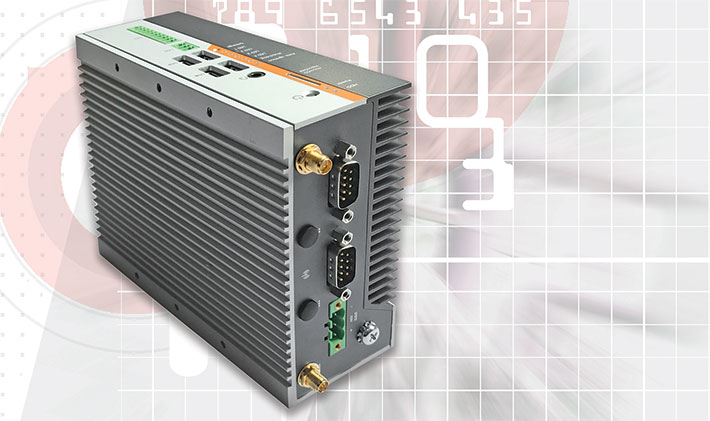
Logic Supply is unusually enthusiastic about their products. Most people don't consider industrial and embedded systems particularly exciting, but the folks at Logic Supply love to talk about their "designed to be redesigned" philosophy, about "mass customization" (using standardized screws, paints, sheet metal folds, and design concepts to keep the cost low), "upgrade kits" as a cost-effective way to cover popular customization options, and their belief in "innovation, not invention!" i.e., adding value to things that work well rather than spending much time trying to re-invent the wheel.
Not your father's global industrial PC company
 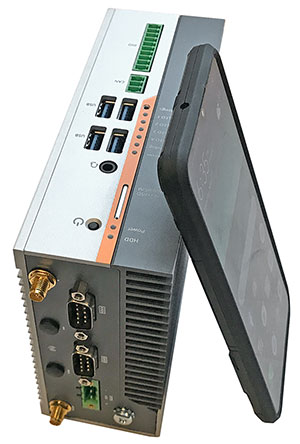 As a result, we've been reviewing Logic Supply industrial computing gear on and off. As a result, we've been reviewing Logic Supply industrial computing gear on and off.
And were always impressed by their quality, packaging, informational materials, and meticulously produced comprehensive manuals. So would we pass an opportunity to take an early look at their new Karbon 300 compact rugged PC? We wouldn't.
Generally, the first thing you notice with most things from Logic Supply is that they really like the color orange. When you google Logic PC, they introduce themselves as "The Original Orange PC."
A look at Logic Supply's website suggests the company is quite fond of the color. This doesn't mean all of their products are orange, but most of their industrial grade embedded PCs are, and that certainly makes for an interesting visual change from the black and gray that bedecks the vast majority of industrial computing gear.
The Logic Supply Karbon 300 webpage boldly proclaims the platform as "the next generation of rugged computing." But what is the Karbon 300? It's not large, measuring just 2.2 x 6.1 x 4.7 inches. A modern smartphone is taller than the Karbon 300.
But what is the Karbon 300 made for? That's up for the customer to decide. It's just a small, handy, compact, tough little computer with exceptionally rich I/O, an exceptionally tough and rugged enclosure, and an exceptionally wide range of potential industrial and vertical market applications. At its launch in March 2019, Logic Supply stressed that the Karbon 300 is built for IoT, the Internet of Things. As sort of an IoT gateway.
IoT Gateway
The "Internet of Things" is one of those not too terribly terrific terms that describes a silent revolution that the population at large isn't even aware of, and even a good number of insiders aren't either. The Internet of Things, IoT in short, describes a world of internet communication that is no longer limited to people or machines communicating with each other. In the IoT, "things" communicate as well. "Things" may be vehicles, cameras, doors, cars, refrigerators, entire homes, sub systems, or entire homes or factories — anything that can measure something and pass that data on for processing and feedback. The total market for all of this combined is gargantuan.
So what is an IoT gateway, and how does it apply to a product like the Karbon 300? By most definitions, the Internet of Things is based on a quad-tier model with, from the bottom to the top:
 - The wireless sensor network level with sensor "mote" edge devices that communicate via standard protocols.
- The embedded IoT gateway level that shares, filters, and transports data.
- The intelligent systems and networking level that manages and analyzes data and turns it into analytics action.
- The cloud where big data and IoT apps and services enable smart transportation, smart buildings, smart process automation, smart energy systems, and numerous other instant-feedback realtime services that were not possible before.
The role of a device such as the Karbon 300 could be to share, filter and transport data from all sorts of sensors up to higher level intelligent systems and from there to the cloud. Because they may be required anywhere and everywhere, an IoT gateway must be small and not use much power. It must be tough and totally reliable, have excellent connectivity, and and allow secure remote management. The Karbon 300 can do all that
Given increasing reliance of "the cloud," the Karbon 300 can also be pre-configured to seamlessly communicate with Amazon Web Services. To do so, AWS IoT Greengrass with Machine Learning (ML) Inference is available as a pre-installed option.
But Logic Supply also mentions Industry 4.0 in its release. So what is that?
Industry 4.0
Right from the horse's mouth: "Computing at the edge is increasingly at the core of today's Industry 4.0 and IIoT solutions," says Logic Supply VP of Products Murat Erdogan. "These devices are being deployed in environments that would quickly destroy traditional computer hardware. The builders and creators we work with require a careful combination of connectivity, processing and environmental protections. With Karbon 300, we're providing the ideal mix of capabilities to help make the next generation of industry-shaping innovation a reality, and enable innovators to truly challenge what's possible." 
By now most know that "Internet of Things" refers to an emerging future where Internet connectivity increasingly includes all sorts of sensor-equipped devices instead of just computers, but what is Industry 4.0, and what do devices like the Karbon 300 bring to the Industry 4.0 table?
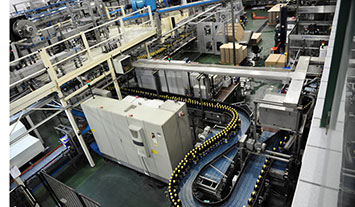 In essence, using the Industry 4.0 nomenclature, In essence, using the Industry 4.0 nomenclature,
- Industry 1.0 was the emergence of mechanical production in the first place (water, steam, etc.),
- Industry 2.0 refers to the introduction of mass production (electricity, assembly lines),
- Industry 3.0 to emerging industrial automation (PCs, robots and such), and now
- Industry 4.0 where intelligent networked systems go beyond mere machine control via feedback systems, interdisciplinary cooperation, IoT technology, and advanced resource/demand management to morph into "intelligent" or at least "smart" factories.
While much of the overall Industry 4.0 concept relies on software, sensor technology and expanded networking, a lot also requires evolved industrial computing hardware that does more than just serve as the basic human-machine interface. Decentralized computing power may be needed anywhere and everywhere, and the more compact and more connected it is the better.
Add to that emerging technologies such as machine vision with their own special requirements such as power over Ethernet or enhanced vision processing, and you get an idea of where small powerful computing devices like the Karbon 300 will fit into both current and evolving Industry 4.0 application requirements.
A song of steel and aluminum
The image below shows top, bottom, fron, back, and one of the two broad side views of the Karbon 300. The device consists of two large and beautifully crafted finned aluminum heat sinks/spreaders, steel sides with cutouts for the various ports, and the 5-3/4 x 4-3/8 inch motherboard. There is no fan; heat is conducted away from the Intel E3950 CPU and other electronics to the two large metal heat sinks via heat-conducting material and then dissipated to the air.

The Karbon 300, like most compact industrial PCs, is a simple and straight-forward design, a precision-engineered piece of computing machinery of very high quality. The design is rational down to the smallest detail. Compact and integrated enough to make for a small and handy package, but still large enough to easily accommodate industry-standard PC ports and modules. Do note, though, that while the Karbon 300 doesn't have a fan or ventilation slots, it is not a sealed unit (and doesn't claim to be).
The picture below shows the system from the top, rear, and front:
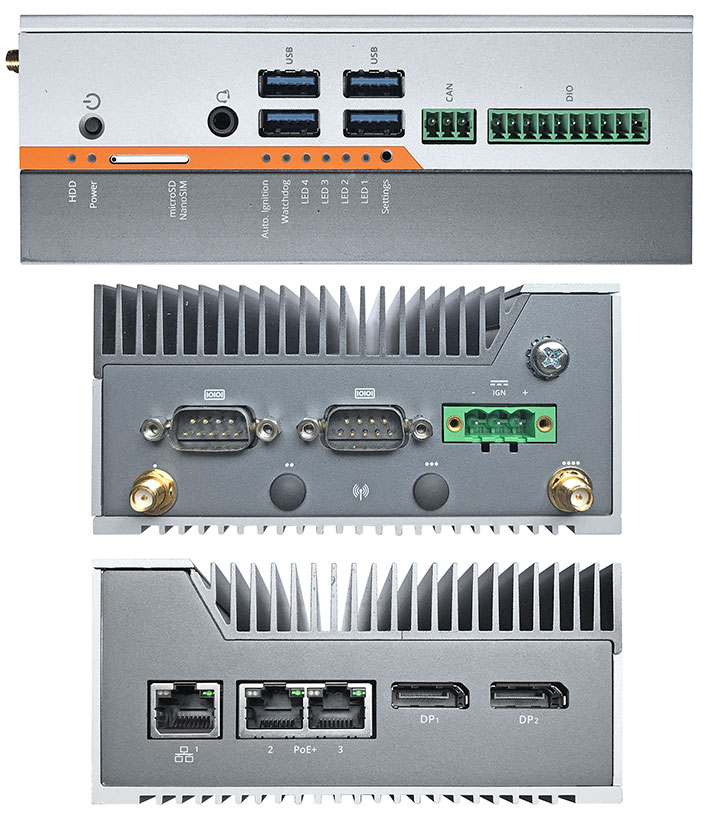
Unlike most industrial and panel PCs where I/O is either in the back or facing down, the Karbon 300 has edge-mounted I/O on three sides — top, front and back. That's because the unit is designed to sit upright, with its two large finned heat sinks freely exposed to cooling air. Our review Karbon 300 provided the following external ports:
- 4 x USB 3.0
- 1 x 3.5mm audio speaker/microphone
- 1 x CAN Bus 2.0B
- 1 x 8-bit Isolated Digital I/O
- 2 x RS232/422/485 serial
- 4 x Antenna cutouts
- 1 x 3-pin Terminal Block connector (9 to 36 VDC)
- 2 x DisplayPort
- 3 x GbE LAN (two of them optionally with PoE)
Our eval had additional cutouts for two DB9-style serial connectors, and another antenna port. There's also a Kensington lock slot for physical security.
Faster storage
As far as mass storage goes, Logic Supply's Karbon 300 is ahead of most of the competition. That's because it uses PCIe NVMe instead of SATA-based technology. To explain the advantage of that we must backtrack a little. For decades, hard disks served as mass storage almost exclusively. Hard disks are complex mechanical devices with rotating platters and fragile read heads. Wear and tear is an issue with hard disks, as are disk crashes die to vibration or impact. 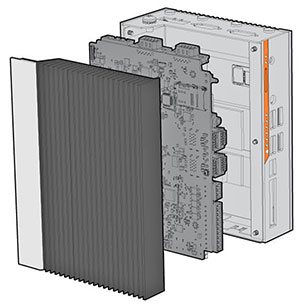 For that reason, hard disks were increasingly replaced by faster and less vulnerable SSDs — solid state disks — in many (and now most) applications. For that reason, hard disks were increasingly replaced by faster and less vulnerable SSDs — solid state disks — in many (and now most) applications.
However, even SSDs have their bottlenecks. In terms of performance, for some time now that bottleneck has been the SATA interface between the storage module and the computer. SATA's been around for a decade and a half and data transmission speed has pretty much maxed out.
The PCIe standard, on the other hand, can reach throughput speeds up to several times higher, depending on which PCIe standard is used and how many "lanes" are available. And PCIe doesn't even require major changes. The standard M.2 connector supports both SATA and PCIe, and PCIe storage modules are the same "gumstick" size as SATA storage modules.
In rugged mobile computers, PCIe's adoption has been slow, despite all of its advantages. It's much to Logic Supply's credit that they made the switch. The pay-off is very noticeably faster "disk" performance.
As is, Logic Supply let's you configure the Karbon 300 with either SATA or PCIe NVMe storage up to 1TB. SATA storage is also available in wide temperature versions.
A peek inside
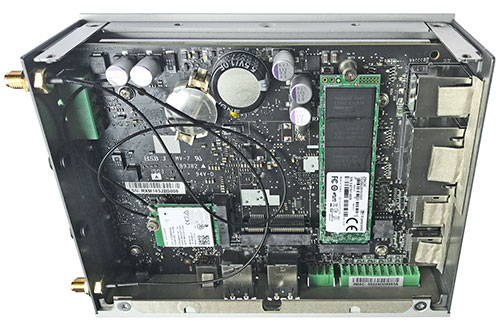 Needless to say, we opened up the Karbon 300 to see how it's built and what it looks like inside. Needless to say, we opened up the Karbon 300 to see how it's built and what it looks like inside.
The housing consists of those two L-shaped aluminum heat sinks with their massive finning. Open a few Torx 10 screws, and one of the aluminum halves easily lifts off, opening access to the top of the motherboard.
There is, however, a caution. With no fan there is no active airflow, and so heat generated by components must be dissipated through the aluminum heatsinks.
That is best done by facilitating direct contact, and Logic Supply does that by liberally applying thermal pads that conduct heat from hot components to the heatsinks. Those thermal soft thermal pads can easily rip and tear. Our Karbon 300 package came with a couple of thermal pad kits, just in case.
Logic Supply says that every component has been thermally optimized to provide reliable wide operating temperature operation, and the chassis is thermally designed to perform in whatever situation it finds itself in, from deserts to glaciers. Below a couple of thermal imaging views of the KARBON 300 while running a benchmark suite, taken with our FLIR One Pro camera.
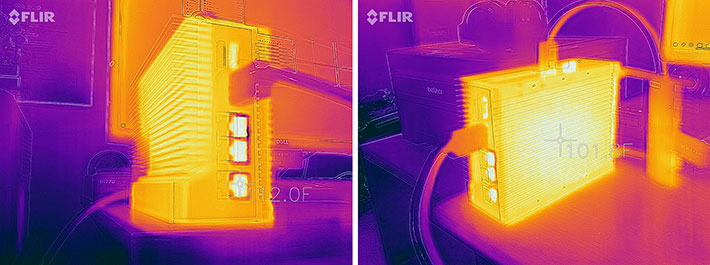
Expansion and vision processing
Why would one open a Karbon 300? Mostly to gain access to the Karbon 300's expansion slots.  In our unit, a 256GB Transcend PCIe NVMe storage module and an Intel Wireless WLAN and Bluetooth module took up the two M.2 slots. The Karbon 300 also has no fewer than four cutouts for external antenna connectors. In our unit, a 256GB Transcend PCIe NVMe storage module and an Intel Wireless WLAN and Bluetooth module took up the two M.2 slots. The Karbon 300 also has no fewer than four cutouts for external antenna connectors.
A standard PCIe connector stood empty. It can be used with the optional Movidius Myriad VPU2 vision processing unit, or whatever other PCIe-based expansion is needed. What would the vision processing unit be used for? That'd be for industrial machine vision projects, facial recognition, machine learning, and emerging AI projects.
For a bit more information on the Movidius Myriad VPU2 and its potential applications as well as details, solutions, etc., see Intel's Movidius information spages here and Logic Supply's own Getting Started with Movidius.
Ruggedness
From a ruggedness standpoint, industrial mini PCs such as the Karbon 300 may encounter temperatures extremes, shock/vibration, and airborne particulates. Since they are not carried around, the drop spec and IP rating (sealing against solids and liquids) that in part define the durability of mobile devices are essentially irrelevant. Shock and vibration resistance, however, are not, and those have been tested to IEC 60068- 2-27 and IEC 60068-2-64 procedures. The operating temperature range is a very wide -13°F to 158°F.
Performance
As an industrial Mini PC suitable for a wide variety of applications, the Karbon 300 is somewhere between a regular personal or business PC and a dedicated embedded computer. Standard desktop PCs need as much performance as possible to be able to handle whatever may come their way. Embedded systems are often targeted at very specific applications that require a certain level of performance and no more. So Logic Supply offers the Karbon 300 with Intel "Apollo Lake" E-Series X5 and X7 processors that offer decent performance without the complexity and power consumption of an Intel Core chip.
Just to provide an idea of the relative performance of the Karbon 300, we ran our two standard benchmark suites, PassMark (both versions 6.1 and 9.0) and CrystalMark. For comparison, we're also listing the results of a Logic Supply mini-ITX systems we've tested, as well as a couple of competitor systems similar to the Karbon 300.
|
Mini-PC/IoT Gateway Systems Benchmarks and Comparisons
|
|
PERFORMANCE COMPARISON
|
Logic Supply
|
Logic Supply
|
Advantech
|
Winmate
|
|
Model
|
Karbon 300
|
ML210G
|
ARK-1122
|
EACIL67
|
|
Model (click pic for review)
|

|

|

|

|
|
Year tested
|
2019
|
2014
|
2015
|
2019
|
|
Intel processor
|
Atom E3950
|
Celeron J1900
|
Celeron J1900
|
Celeron N3350
|
|
Cores/threads
|
4/4
|
4/4
|
4/4
|
2/2
|
|
CPU base speed
|
1.60GHz
|
2.00GHz
|
2.00GHz
|
1.10GHz
|
|
CPU turbo speed
|
2.00GHz
|
2.41GHz
|
2.41GHz
|
2.40GHz
|
|
Thermal Design Power (TDP)
|
12.0 watts
|
10.0 watts
|
10.0 watts
|
6.0 watts
|
|
PassMark 6.1
|
1,347.9
|
1,316.0
|
787.2
|
NA
|
|
PassMark 9.0
|
1,030.6
|
NA
|
NA
|
901.1
|
|
Overall CrystalMark
|
143,195
|
139,652
|
91,261
|
103,533
|
The results show three things:
- First, the quad-core Atom X7-E3950 Logic Supply picked for their Karbon 300 industrial Mini PC packs a decent punch. Although based on a heavily revised Atom processor architecture, Intel's "second tier" of processors that are less complex and require less power than Core CPUs often provide near Core processor performance, but in much more economical packages.
- Second, these Bay Trail and now Apollo Lake-based system perform at a much higher level than anything based on earlier Intel Atom processors.
- And third, the type of solid state storage chose for a particular system can make a big performance difference. That was the case with the Logic Supply ML210G we tested a few years ago, and now even more so with the PCIe NVMe-equipped Karbon 300.
The Karbon 300 by Logic Supply
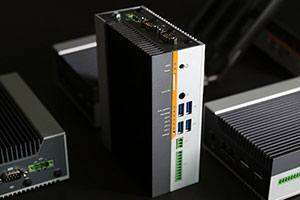 The box our review Karbon 300 came in had a classy golden sticker on it, because our tester was a "Pioneer Edition." The box our review Karbon 300 came in had a classy golden sticker on it, because our tester was a "Pioneer Edition."
The sticker said that they sent it it to us as innovators (well, we really only analyze and report), and that Logic Supply wanted to learn how the Karbon 300 could be used to transcend expectations and challenge what's possible.
First, that's the spirit, Logic Supply!
Second, the way we see it, this tough little PC is truly a sampler of what all is possible, a smorgasbord of standards, connectivity, functionality and options. Just the tool one needs to push the frontier. Be it within IoT, be it in Industry 4.0 and machine vision, be it in a thousand other emerging applications.
-- Conrad H. Blickenstorfer, May 2019
Logic Supply Karbon 300 Specs:
| Status |
Added and reviewed 05/2019
|
| Type |
Rugged Industrial Mini PC
|
| CPU Type |
Quad-core Intel "Apollo Lake" Atom X7-E3950
Dual-core Intel "Apollo Lake" Atom X5-E3930
|
| CPU speed |
E3950: 1.60GHz, 2.00GHz burst frequency
E3930: 1.30GHz, 1.80GHz burst frequency
|
| Graphics |
E3950: Intel® HD Graphics 505 (500/650MHz, 18EUs)
E3930: Intel® HD Graphics 500 (400/550MHz, 12EUs)
Optional Movidius Myriad VPU2 vision processing unit |
| OS |
Windows 10Home/Pro/IoT Enterprise, Ubuntu Linux Server/Desktop, AWS IoT Greengrass w/ Ubuntu image
|
| Memory |
4GB or 8GB dual-channel soldered LPDDR4
|
| Watchdog Timer |
Unknown |
| Graphics Interface |
2 x DisplayPort
|
| LAN |
3 x GbE LAN (2 of them optionally PoE), Intel I210IT GbE LAN controller |
| Expansion |
1 x Full-size mPCIe, 1 x M.2 2230 slot, 1 x Nano-SIM slot (4FF); optional Intel Movidius Vision Processing Unit (VPU)
|
| Storage |
PCIe x2 NVMe or SATA SSD in M.2 22x80 slot (mPCI NVMe Transcend 256GB in test unit)
|
| Housing |
Steel case with finned aluminum heatsink upper and lower, DIN-mount, VESA-mount, wall-mount
|
| Shock/Vibration |
IEC 60068- 2-27 and IEC 60068-2-64 procedures
|
| EMC |
Meets in-vehicle UNECE Reg.10 E-mark and rolling stock EN50155 standard
|
| Regulatory |
2011/65/EU (RoHS 2 Directive)
Additional Safety and EMC certifications pending, CE, EN 55024, EN 55032, EN 62368-1, FCC 47 CFR Part 15, IEC 60068-2-27, IEC 60068-2-64
|
| Operating temperature |
-13°F to 158°F (-25°C to 70°C)
|
| USB |
4 x USB 3.0
|
| Serial |
2 x RS232/422/485 serial |
| Digital I/O |
1 x 8-bit Isolated Digital I/O |
| CAN Bus |
1 x 3-pin CAN bus 2.0B
|
| Audio |
3.5mm audio jack (Line-Out; Mic-In) |
| Communication |
Optional via M.2 2230: Intel Wireless AC and Bluetooth 8260NGW, Intel Wireless-AC 9260 802.11ac Wi-Fi & BT5.0, Sierra Wireless 4G LTE for AT&T or Verizon
4x Antenna holes
|
| Size |
2.2 x 6.1 x 4.7 inches (56 x 154 x 119 mm)
|
| Weight |
3.0 pounds as tested |
| Power |
Wide-input 9 to 36 VDC with automotive intelligence, 3-pin Terminal Block connector
|
| Price |
Starting at US$649 |
| Webpage |
Logic Supply Karbon 300 page |
| Purchase and specs |
Logic Supply Karbon 300 manual |
|



